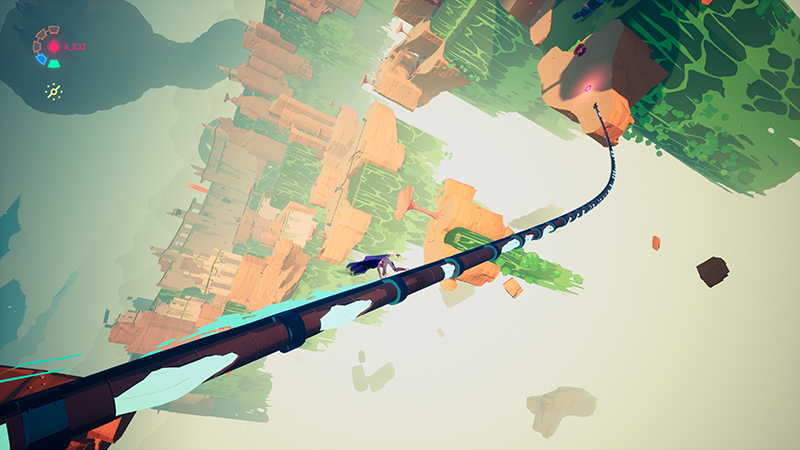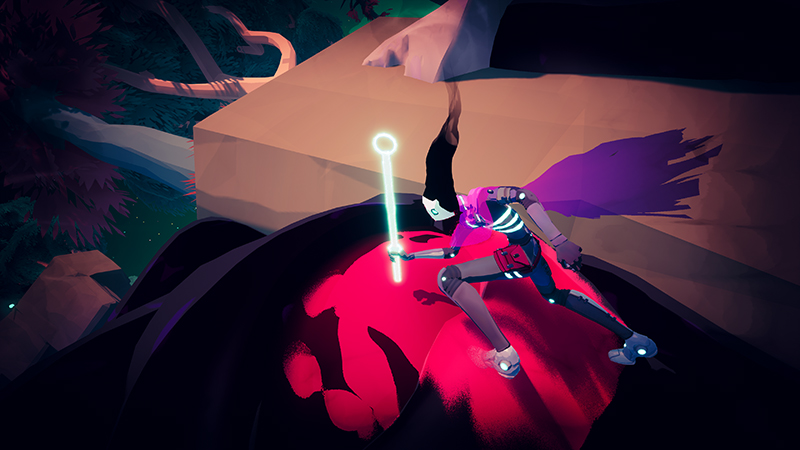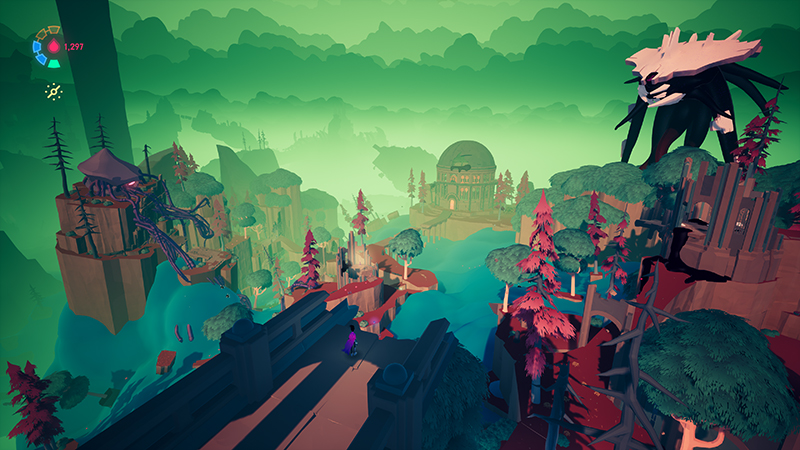Developer Heart Machine’s first title, Hyper Light Drifter, was a solid debut that took the trappings of an early 2D Legend of Zelda game and layered in a beautiful pixelated aesthetic and simple yet satisfying combat system. Solar Ash, the team’s second game, is radically different, keeping an inherently alluring visual style, but taking place in a small, 3D semi-open world. However, unlike the studio’s last game, Solar Ash lacks any sort of mechanical complexity or narrative hooks and is a thoroughly unfulfilling and hollow experience.
Solar Ash initially appears as though it has some potential. Rei, the protagonist, can freely skate around, grind along rails, and grapple to certain points, all of which are meant to be chained together to create a rousing sense of speed as players fluidly blaze through environments with no interruption. Sometimes, that is the case, but it’s often underwhelming and falls short of what it could be.

Rei’s movements don’t have much momentum so they lack the buildup of velocity that comes from many great traversal-focused games. She just skates and grinds at a fairly leisurely pace. For as much as this game feels like some sort of Sonic spin-off, it doesn’t match the impatient hedgehog’s pace.
It’s not even deep enough to make up for its lack of agility. Grappling, skating, and grinding are all surface-level interactions that never grow in complexity as the game unfolds. The level design hardly demands much of players and gives them the same basic jungle gyms in each environment. There are a few very minor tweaks like plants that use spores from other plants as keys and grindable vines that have to be activated first, but it’s not enough and isn’t a change of pace that brings any meaningful challenge.
And since there’s hardly any challenge, there’s also hardly any satisfaction to be had since there are no deep mechanics to master. An upgrade tree isn’t essential, but getting new moves or augmenting current ones would naturally change up the gameplay. Repetitive stages with stale mechanics that don’t evolve means Solar Ash gets old quickly.

Its repetition sets in even more when mindlessly cruising down the critical path. Each territory has a boss fight that unlocks after stabbing a certain amount of goopy, evil eyeballs around the stage. And each eyeball has an obstacle course of targets that have to be slashed within a certain time period before the eye itself can be impaled.
Timed trials seem like a decent way to put the game’s central movement mechanics to the test, but, again, they’re relatively simple most of the time and don’t actually pressure the player, evolve, or push them to get better. This setup applies to each level, meaning it gets extremely repetitive and predictable. Even boss fights, while wonderfully creative from a visual standpoint and awe-strikingly big in a Shadow of the Colossus type of way, follow the same formula as each other and the levels they’re in: slash the targets within a certain time limit to stab the eye. Moving rapidly and hacking away as the timer ticks down can be momentarily thrilling, but it’s just a fleeting tease that passes swiftly.

While Solar Ash’s gameplay is dull, its world is the opposite. Each of its biomes is diverse — one is a government sector covered in acid, while another is a multilayered, gravity-bending area drenched in lava — but all are as gorgeous as they are expansive. The wide palette of bright colors is especially stunning when perched atop one of the game’s many tall structures that offer a solid look at the land. There’s not much reason to explore those areas, but they sure look amazing from that high up because of its simple yet vibrant art style that also works in tandem with its smooth, ambient soundtrack.
There’s not much reason to explore because the pink blobs used for currency that are scattered around are essentially useless and the scant collectibles are boring to read through; a symptom of the game’s weak narrative. Rei’s mission to save her planet from certain death is a noble deed, but the game attaches that plot to barren characters with almost no personality. There’s nothing to anchor its story to, which makes it impossible to connect to any of it from the few side characters to Rei herself. The single point of interest that comes up near the very end is far too little that comes far too late. Hyper Light Drifter’s dialogue-free story may have been hard to grasp at times, but at least it had compelling pieces to follow with an interesting, flawed protagonist.
Solar Ash is a little more ambitious than Hyper Light Drifter with its jump to 3D, but it has traded ambition for quality. The gameplay puts up the impression that it wants to be a kinetic platformer, yet it’s a shallow imitation of one that repeats a depressing number of times before it hits credits. Like a solar flare, Solar Ash hits players with a sharp burst of energy as it opens with some promising, speedy mechanics. But that energy quickly dissipates as it loses momentum right after its initial explosion as it trudges from level to level and never picks back up.
SCORE: 5.5/10
As ComingSoon’s review policy explains, a score of 5 equates to “Mediocre.” The positives and negatives wind up negating each other, making it a wash.










